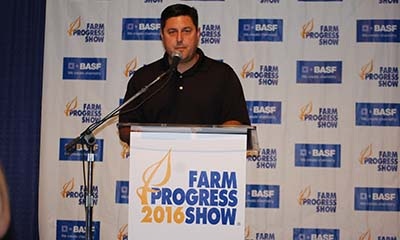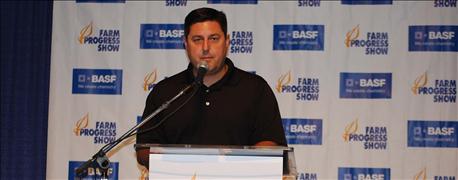
Illinois farmland prices are off in the first 6 months of 2016, from 3% on Class A land, to 7% in other parts of the state. Further, according to the mid-year survey from the Illinois Society of Professional Farm Managers and Rural Appraisers, farm managers are anticipating lower cash rents in 2017 and movement to more variable leases.
“The good news is, for farmland buyers, there are going to be opportunities,” says David Klein, Soy Capital Ag Services. “Opportunities will exist at levels not seen since 2011.” He adds that favorable interest rates should stay for the remainder of the year, according to survey results.

HIGH DEMAND: “Farmland is a unique asset class and people see that outside of the ag community as well,” says David Klein, Soy Capital Ag Services. “If people are willing to step in and purchase when farmers don’t have the cash flow to make those acquisitions in the next year, there will still be a demand base for high-quality farmland.”
Klein shared survey results on the second day of the Farm Progress Show in Boone, Iowa.
“As many expect, farmland prices have somewhat decreased in the first 6 months of the year,” Klein explains. “Class A land has decreased roughly 3%, as you go down the quality chain, farmland values decreased as much as 7% in certain parts of the state.”
Survey respondents estimated that farmland prices averaged $11,100 for excellent quality farmland, $9,400 for good quality farmland, $7,600 for average quality farmland, and $5,800 for fair quality farmland.
Most survey respondents expect this decline to continue during the last half of the year, due to lower net returns and commodity prices.
Klein adds that soil quality and the percent of tillable land impacts price levels, and that farmers and investors are still looking for high-quality land. Inventory also kept land prices steady, with fewer acres up for sale during the first half of the year.
The majority of land buyers remain farmers, but Klein anticipates an increase in outside investors who see farmland as a way to diversify their long-term portfolio.
He adds more farmers are using financing compared to a few years ago and that low Interest rates help. But as commodity prices remain low, lenders will keep a close eye on cash-flow and lending standards.
Cash Rent
As farmers plan for 2017 input costs, cash rent discussions start to occur. Klein says survey respondents anticipate cash rent to come in $20 an acre lower than 2016.
“When there’s less money in the bucket in the end, it has to be spread out somewhere,” Klein notes.
He also anticipates more variable cash-rent leases, with a base rent plus bonus if revenues are higher than anticipated. “Farmers have to make something or break even,” Klein says. A variable-cash rent lease “allows some flexibility to recapture some of that potential lost revenue.”
About the Author(s)
You May Also Like




